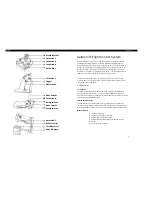
Cortex-M3 Processor (Reference Material)
UG0331 User Guide Revision 15.0
109
3.7.2.8
System Handler Priority Registers
The SHPR1-SHPR3 registers set the priority level, 0 to 255 of the exception handlers that have
configurable priority.
SHPR1-SHPR3 are byte accessible. See the register summary in
page 102 for their attributes.
The system fault handlers and the priority field and register for each handler are:
Each PRI_N field is 8 bits wide, but the processor implements only bits [7:M] of each field, and bits [M-
1:0] read as zero and ignore writes.
[7:5]
Reserved.
[4]
DIV_0_TRP
Enables faulting or halting when the processor executes an SDIV or UDIV
instruction with a divisor of 0:
0: do not trap divide by 0
1: trap divide by 0.
When this bit is set to 0, a divide by zero returns a quotient of 0.
[3]
UNALIGN_TRP
Enables unaligned access traps:
0: do not trap unaligned halfword and word accesses
1: trap unaligned halfword and word accesses.
If this bit is set to 1, an unaligned access generates a UsageFault.
Unaligned LDM, STM, LDRD, and STRD instructions always fault irrespective of
whether UNALIGN_TRP is set to 1.
[2]
Reserved.
[1]
USERSETMPEND
Enables unprivileged software access to the STIR, see
0: disable
1: enable
[0]
NONBASETHRDEN
A
Indicates how the processor enters Thread mode:
0: processor can enter Thread mode only when no exception is active.
1: processor can enter Thread mode from any level using the appropriate
EXC_RETURN value, see
Table 59 •
System Fault Handler Priority Fields
Handler
Field
See
MemManage
PRI_4
System Handler Priority Register 2,
BusFault
PRI_5
UsageFault
PRI_6
SVCall
PRI_11
System Handler Priority Register 2,
PendSV
PRI_14
System Handler Priority Register 2,
SysTick
PRI_15
Table 58 •
CCR Bit Assignments
(continued)
Bits
Name
Function
















































